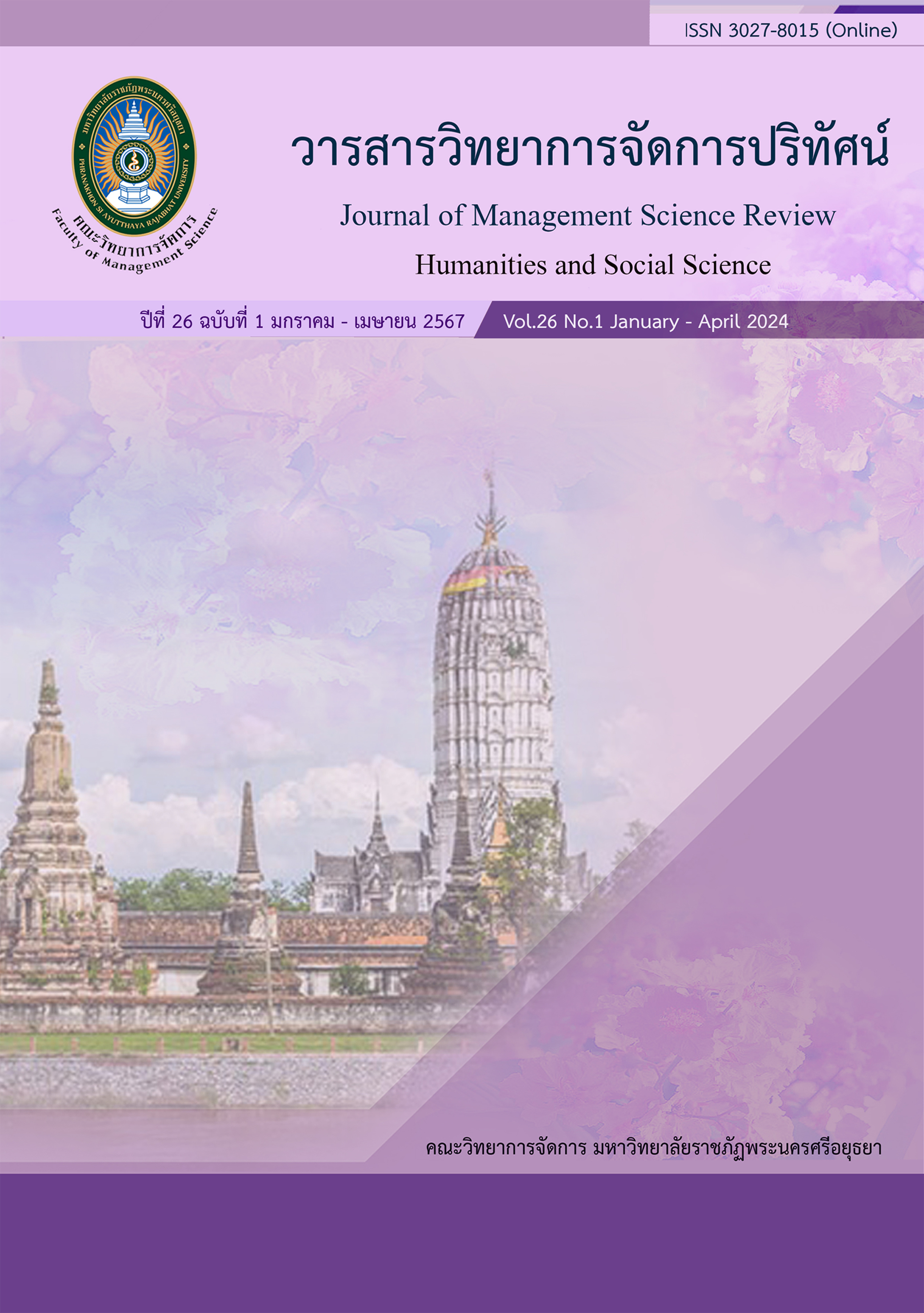รูปแบบกลยุทธ์ส่วนประสมการตลาดบริการสำหรับธุรกิจสปาและนวดแผนไทย ในจังหวัดสมุทรปราการ
คำสำคัญ:
รูปแบบกลยุทธ์, ส่วนประสมการตลาดบริการ, ธุรกิจสปาและนวดแผนไทย, การตัดสินใจบทคัดย่อ
การวิจัยนี้มีวัตถุประสงค์เพื่อ 1) เปรียบเทียบกระบวนการตัดสินใจเลือกใช้บริการสปาและนวดแผนไทยของผู้บริโภค จำแนกตามข้อมูลส่วนบุคคล 2) ศึกษาส่วนประสมการตลาดบริการที่มีอิทธิพลต่อการตัดสินใจเลือกใช้บริการ สปาและนวดแผนไทยของผู้บริโภค จำแนกตามกลุ่มข้อมูลส่วนบุคคลที่มีกระบวนการตัดสินใจเลือกใช้บริการสปาและนวดแผนไทยแตกต่างกัน 3) ศึกษารูปแบบกลยุทธ์ส่วนประสมการตลาดบริการสำหรับธุรกิจสปาและนวดแผนไทย กลุ่มตัวอย่างคือผู้บริโภคที่มาใช้บริการสปาและนวดแผนไทยในจังหวัดสมุทรปราการจำนวน 400 คน สุ่มตัวอย่างด้วยวิธีเจาะจง เก็บรวบรวมข้อมูลด้วยแบบสอบถามที่มีความเชื่อมั่น .97 วิเคราะห์ข้อมูลใช้ ค่าเฉลี่ย ส่วนเบี่ยงเบนมาตรฐาน t-test ANOVA และการวิเคราะห์ถดถอยเชิงพหุ (Multiple Regression analysis) ด้วยวิธี stepwise
ผลการวิจัยพบว่า 1) ผู้บริโภคที่มีอาชีพรับราชการ/รัฐวิสาหกิจ พนักงานบริษัท/ลูกจ้าง และไม่ได้ประกอบอาชีพ มีกระบวนการตัดสินใจเลือกใช้บริการสปาและนวดแผนไทยแตกต่างจากอาชีพอิสระ/รับจ้างทั่วไป นอกนั้นไม่แตกต่างกัน 2) ส่วนประสมการตลาดบริการที่มีอิทธิพลเชิงบวกต่อการตัดสินใจเลือกใช้บริการสปาและนวดแผนไทยของผู้บริโภคอาชีพรับราชการ/รัฐวิสาหกิจ พนักงานบริษัท/ลูกจ้าง และไม่ได้ประกอบอาชีพ ได้แก่ ด้านภูมิทัศน์แหล่งบริการ ด้านการจัดจำหน่าย/สถานที่ ด้านผลิตภัณฑ์ และด้านกระบวนการ ส่วนด้านผู้ให้บริการมีอิทธิพลเชิงลบ และส่วนประสมการตลาดบริการที่มีอิทธิพลเชิงบวกต่อการตัดสินใจเลือกใช้บริการสปาและนวดแผนไทยของผู้บริโภคอาชีพอิสระ/รับจ้างทั่วไป ได้แก่ ด้านผลิตภัณฑ์ ด้านผู้ให้บริการ และด้านราคา 3) รูปแบบกลยุทธ์ส่วนประสมการตลาดบริการสำหรับธุรกิจ สปาและนวดแผนไทย มี 2 รูปแบบ
เอกสารอ้างอิง
Bangkok Thurakit. (2022). Spa business tends to grow 17% per year after the COVID-19 crisis. Retrieved from https://www.bangkokbiznews.com/social /983284
Chanthanawan, S., & Fongthanakit, R. (2019). Factors affecting decision making on using spa service towards consumers in Chatuchak district, Bangkok. Journal of the Association of Researchers, 24(3), 190-204.
Cochran, W. G. (1953). Sampling Techniques. New York: John Wiley & Sons.
Dhurakij Pundit University. (n.d.). Opening the new era massage-spa model. Retrieved from https:// www.dpu.ac.th/research/8
Hair, J. F., Black, W. C., Babin, B. J., & Anderson, R. E. (2014). Multivariate Data Analysis (17 th ed.). USA: Pearson education.
Kitkasachareon, P., & Boonchai, P. (2018). Research report on the marketing potential development and needs of Thai herbs in spa business to promote medical tourism. Bangkok: Rajamangala University of Technology Rattanakosin.
Klunpakdee, P., Sangpikul, A., & Kumsuprom, S. (2020.Thai world class spa business development in Thailand towards sustainability. Journal of Public Health of Thailand, 29(6), 1147-1156.
Kotler, P., & Armstrong, G. (2016). Principles of marketing (16 th ed.). England: Pearson Education.
Panapitai, T., & Itsuwan Kang, N. (2021). Behaviors and factors affecting the decision-making of Thai tourists in Pattaya in using health spa services. Sripatum Chonburi Academic Journal, 17(4),69-79.
Promhitathorn, S. (2017). Factors that affect satisfaction in using day spa health spa services among users in Bangkok and surrounding areas. [Master’s thesis]. Thammasat University.
Phusee-orn, S. (2008). Application of SPSS to analyze research data (2 nd ed.) Kalasin: Prasarn Publishing.
Pichetweerachai, W. (2018). The selection of the service marketing mix 7Ps in Thai massage services from the perspectives of Thai consumers. Dusit Thani College Journal, 12(3), 219-246.
Rittiboonchai, W. (2020). Marketing mix factors affecting to decision-making of tourists on using Thai massage services from Wat Pho Thai Traditional Medical School. UMT-Poly Journal, 17(1), 196-206.
Rungruangkolllakit, P. (2020). A study of customer experience of traditional spas for the development of spa at home services for Thai office workers. [Master’s thesis). Thammasat university.
Schiffman, L.G., & Wisenblit, J. (2015). Consumer Behavior (11 th ed.). England: Pearson Education.
Simasathiansophon, N. (2019). Development of marketing mix strategy for spa business. International Journal of Recent Technology and Engineering (IJRTE), 8(2S11), 4162-4165.
Somvipat, W., Pukkayaporn, S., Nititum, W., & Naksuk, W. (2021). Roles of managers in managing spa businesses for success. Journal of Graduate Review Nakhon Sawan Buddhist Colleg, 9(1), 113-128.
Spa Born. (n.d.). Types of spa massage businesses that you should know. Retrieved from https://www.spaborn.com.
Strategy and Information for Provincial Development Group Samut Prakan Provincial Office. (n.d.). Samut Prakan Province 5-year development plan (2023-2670). Retrieved from https://gdcatalog.go.th/dataset/gdpublish-smk01/resource.
Sukchom, M., & Rod-iam, U. (2013). Study of the relationship between service marketing mix factors and service behavior of Thai massage consumers in Bangkok metropolitan hospitals. area. Academic Services Journal, 24(4), 104.
Teerakwanroj, T., & Kritsadathan, S. (2020). Service marketing. Bangkok: Se-Education.
Tepprasit, P., Sakulwongsirichok, P., & Paopan, N. (2021). The decision-making paths analysis and factors influence users’ repurchase of Thai massage. The Business Review Journal, 13(2), 164-180.
TWN Thailand Holistic Health. (2019). 3 marketing strategies for spa massage shop operators. Retrieved from https://www.thailandholistic.com/3-tactics-marketing.
Wansiri, S. (2021). Strategic management for the impact of Covid-19 in health massage wellness and spa Thai business. [Master’s thesis]. Mahidol University.
G E-learning. (2017). Services Marketing and Customer Relationship Management. USA: 3G E-learning LLC.





